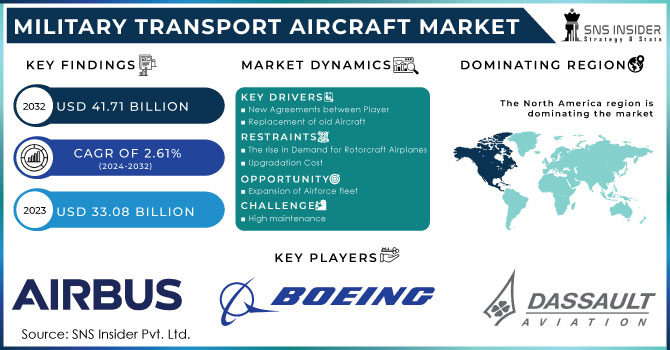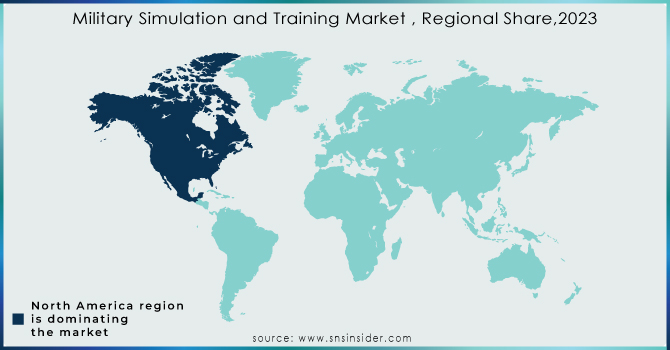Military Simulation and Training Market Report Scope & Overview:

To get more information on Military Simulation and Training Market - Request Free Sample Report
The Military Simulation and Training Market was valued at US$ 13.65 Billion in 2023. The market is expected to reach US $ 20.82 billion by 2032 with a CAGR of 4.8% from 2024 to 2032.
The global military simulation and visual training are driven mainly by military field procurement programs by several armed forces around the world. Also, the military incorporates simulation-based training methods to ensure safety, reduce operating costs, and the aging of equipment associated with real-time training. As several security services around the world look to improve operational efficiency, the demand for low-cost, high-performance artificial intelligence (AI) systems is expected to grow during the forecast period. In addition, technology to develop military training simulations has become more affordable, which has also led to the growth of national security and border patrol simulations.
KEY DRIVERS
Safety has been a major factor in the launch of pilot training. Visual aviation training has recently gained importance due to its many benefits, such as effective training in real-time observation, reduced environmental impact, and cost-effectiveness. Most flight and training is done with full flight simulations. Simulation-based training keeps pilots and instructors in low-risk environments, allows for extreme situations, and prevents trainees from damaging expensive aircraft. Simulators can also operate more than 20 hours a day by emitting 22 times lower carbon costs than operating aircraft pilots. In the case of aeronautics, flight simulation is a common practice in mechanical training, such as computer-based drone training.
Many flight exercises have been replaced by simulation training and have been adopted by flight crews. The increase in fighter jet risks increases the need for simulation-based training to ensure safer aircraft.
RESTRAINTS
The high cost of military imitation and practical training and the lack of skilled professionals hamper the growth and development of the military simulation market and practical training. these barriers need to be managed well to grow better.
OPPORTUNITIES
Mental instability in all non-industrial nations may hinder military imitation and the development of a tangible training market. military simulation and a visual training industry research report recommend that organizations in the visual training business sector can be supported by the continuation of equipment such as speculation and defense use over a limited period. the global market for military simulation and virtual training is designed to register development at a high rate from these key components. the market is spread across different regions around the world. the military simulation market and virtual training will look at major developments across the stage, preparing the genre, and regional divisions.
CHALLENGES
Product development in the simulation market is a long process, as it takes significant time to build a model for any tested aircraft. Aircraft simplification engineers also need OEM authorization to design an aircraft model, which adds time and cost to development. Manufacturers also need to provide customer-focused products that are flexible and adapt to the needs of customers while allowing them to adapt to the changing nature of driver training. They also need to keep up with security and control issues, which makes it difficult to deliver the required characters on time.
Market Segmentation
Based on the application, the military simulation market and visual training are divided into different segments such as airborne, maritime, and land. the aerial part is divided into a plane, a flying plane, and a UAV plane. part of the sea is divided into transport scaffolds, submarines, and more
Based on the type of training have divided military simulation and the visual training market into live, practical, visual, and playful programs. a lively preparation piece surpasses a fixed market. it is hoped that you will continue to do so in the next five years, as live preparation provides real-life simulations that bring real people into the real world.
Based on the region, the APAC region is expected to develop at its highest rate over some time. For example, the countries of India and China have expanded their military and financial systems and are gradually acquiring military resources. therefore, it is important to have military personnel training, relied on an owner to run the military simulation market, and practical training.
THE IMPACT OF COVID-19
The COVID-19 epidemic has wreaked havoc on the world's economic activities. The development of digital battlefield products, including systems, sub-systems, and components, has also had an impact. All the military simulation and defense employment training products are very much important, disruptions in the supply chain have halted their current production process. Resumption of production activities depends on exposure to COVID-19, the extent to which production operations are performed, and the import and export regulations, among other factors. While companies may still take orders, delivery schedules may not be adjusted. Many of the key players in the war simulation market and training such as Lockheed Martin Corporation (US), Raytheon Technologies (US), and Rheinmetall AG (Germany) have announced that the business has returned to normal but acknowledged the cost and sc.
KEY MARKET SEGMENTATION
By Type
-
Live
-
Virtual
-
Constructive
By Application
-
Army
-
Aviation
-
Naval
By Platform
-
Land
-
Maritime
-
Airborne
By Environment
-
Synthetic
-
Gaming
By Solution
-
Product
-
Services
By Technology
-
IoT
-
5G
-
Artificial Intelligence
-
Cloud Computing and Master Data Management
REGIONAL ANALYSIS:
International military simulation and practical training The North American business area include military simulation and virtual training markets throughout Mexico, the united states, Canada, and more. organizations present in the military simulation and virtual training market are also profiled, and their strategies are fully introduced to the market. The military parade market and practical training throughout the European region include France, Germany, Italy, and the United Kingdom. In addition, the Market provides information about the APAC region which includes military recreation and preparatory markets from China, Australia, India, Japan, and others. The Market is also strong in every few parts of the world.

Need any customization research on Military Simulation and Training Market - Enquiry Now
REGIONAL COVERAGE:
North America
-
USA
-
Canada
-
Mexico
Europe
-
Germany
-
UK
-
France
-
Italy
-
Spain
-
The Netherlands
-
Rest of Europe
Asia-Pacific
-
Japan
-
South Korea
-
China
-
India
-
Australia
-
Rest of Asia-Pacific
The Middle East & Africa
-
Israel
-
UAE
-
South Africa
-
Rest of the Middle East & Africa
Latin America
-
Brazil
-
Argentina
-
Rest of Latin America
KEY PLAYERS
The Key Players are CAE, Inc., Israel Aerospace Industries Ltd., Lockheed Martin Corporation, Meggitt PLC, Northrop Grumman Corporation, Raytheon Technologies, Rheinmetall AG, SAAB AB, Textron Inc., Thales Group & Other Players.
| Report Attributes | Details |
|---|---|
| Market Size in 2023 | US$ 13.65 Billion |
| Market Size by 2032 | US$ 20.82 Billion |
| CAGR | CAGR of 4.8% From 2024 to 2032 |
| Base Year | 2023 |
| Forecast Period | 2024-2032 |
| Historical Data | 2020-2022 |
| Report Scope & Coverage | Market Size, Segments Analysis, Competitive Landscape, Regional Analysis, DROC & SWOT Analysis, Forecast Outlook |
| Key Segments | • By Application (Airborne Simulation, Naval Simulation, Ground Simulation) • By Training Type (Live Training, Virtual Training, Constructive Training, Gaming Simulation Training) |
| Regional Analysis/Coverage | North America (USA, Canada, Mexico), Europe (Germany, UK, France, Italy, Spain, Netherlands, Rest of Europe), Asia-Pacific (Japan, South Korea, China, India, Australia, Rest of Asia-Pacific), The Middle East & Africa (Israel, UAE, South Africa, Rest of Middle East & Africa), Latin America (Brazil, Argentina, Rest of Latin America) |
| Company Profiles | CAE, Inc., Israel Aerospace Industries Ltd., Lockheed Martin Corporation, Meggitt PLC, Northrop Grumman Corporation, Raytheon Technologies, Rheinmetall AG, SAAB AB, Textron Inc., Thales Group. |

